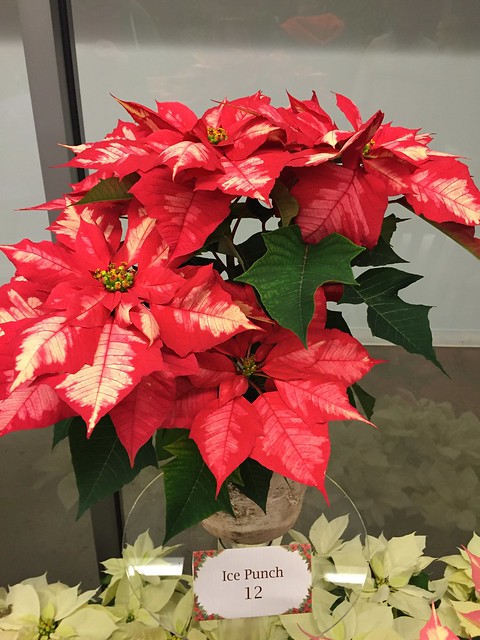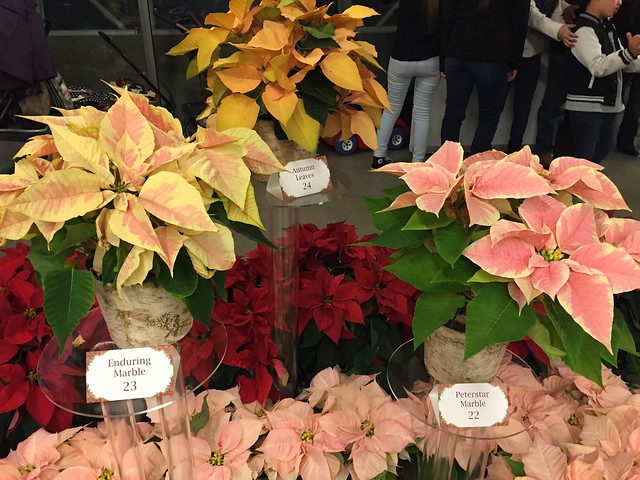It's been AGES since I last posted! Sorry about that, loyal followers. Life has been busy and I have added some new hobbies, which have diverted my attention and time away from the blog. Now, let's talk about poinsettias!

I'm not entirely sure why I typed that title for the post. Now that I have, I have a lot to discuss. My inspiration for the post was when I visited the good old Myriad Botanic Gardens in Oklahoma City a couple of weeks ago. To be honest, I have been a little disheartened with the direction of the gardens since the garden ownership changed a few years ago. There is a lot more marketing (good) but a lot of it seems to have nothing to do with plants (sad).


Anyway, that being said, when we were at the gardens a couple of weeks ago they had the whole placed decked out for the holidays and the conservatory was lit up with Christmas lights. (All normal lighting was turned off, so you couldn't really see the plants.) In the lobby area they had tons of Poinsettias. At first I walked by them, not realizing there was something special about this temporary splash of holiday color. There were SIGNS by each of these plants. (I can't tell you how many times I have been in botanic gardens and seen a plant or tree that I didn't know and I couldn't find a label for it anywhere.) The signs caught my attention and then I noticed these Poinsettias were not all the same. And I don't mean they were just different colors. There were striking differences.


I was really delighted to see that the Myriad had gone out of their way to track down some named varieties that were different from the norm. They were only lacking a bit more signage to call people's attention to the understated exhibit. It could be pretty educational, describing what a cultivar is, how they are selected and bred, and how the horticulture industry works. It's all in my head.

Now back to my title, I think the Poinsettia is misunderstood. First, the Poinsettia is Euphorbia pulcherrima, belonging to the huge Eurphorbia genus, which mostly consists of succulent plants that the average person would call "cacti." You wouldn't know it with a quick look at the Poinsettia, but it's true. Now maybe the Poinsettia is saying "Hey, that's just my crazy family. I'm nothing like those spiky beasts." But they are closely related. Second, those colorful "flowers" that everyone loves at Christmas time... well, they're not really flowers. Those are colored leaves, called bracts. The flowers are the small yellow bits in the middle. Third, they just don't look like that in the wild. The compact potted plants sold all over the place between Thanksgiving and Christmas have been grafted and bred for those traits. The natural species is much more lanky and with less prominent colorful bracts. Fourth, the rumors of their toxicity are hyperbolic. Most people will have little to no reaction from the sap. Others could have some skin irritation. If you were to each a leaf, you might puke. You would have to eat a lot of Poinsettias to have anything close to a fatal dose.

Finally, I will leave you with some photos of a favorite relative of mine. It is the Jamaican Poinsettia Tree (Euphorbia punicea). There is a large specimen at the Myriad Botanic Gardens and I have also seen this tree growing outdoors at a botanic garden in Florida.
 Euphorbia punicea (Jamaican Poinsettia tree) at Fairchild Tropical Botanic Gardens, Miami, Florida.
Euphorbia punicea (Jamaican Poinsettia tree) at Fairchild Tropical Botanic Gardens, Miami, Florida.
 Jamaican Poinsettia Tree - macro view of flower. Myriad Botanic Gardens, Oklahoma City, Oklahoma.
Jamaican Poinsettia Tree - macro view of flower. Myriad Botanic Gardens, Oklahoma City, Oklahoma.

I'm not entirely sure why I typed that title for the post. Now that I have, I have a lot to discuss. My inspiration for the post was when I visited the good old Myriad Botanic Gardens in Oklahoma City a couple of weeks ago. To be honest, I have been a little disheartened with the direction of the gardens since the garden ownership changed a few years ago. There is a lot more marketing (good) but a lot of it seems to have nothing to do with plants (sad).


Anyway, that being said, when we were at the gardens a couple of weeks ago they had the whole placed decked out for the holidays and the conservatory was lit up with Christmas lights. (All normal lighting was turned off, so you couldn't really see the plants.) In the lobby area they had tons of Poinsettias. At first I walked by them, not realizing there was something special about this temporary splash of holiday color. There were SIGNS by each of these plants. (I can't tell you how many times I have been in botanic gardens and seen a plant or tree that I didn't know and I couldn't find a label for it anywhere.) The signs caught my attention and then I noticed these Poinsettias were not all the same. And I don't mean they were just different colors. There were striking differences.


I was really delighted to see that the Myriad had gone out of their way to track down some named varieties that were different from the norm. They were only lacking a bit more signage to call people's attention to the understated exhibit. It could be pretty educational, describing what a cultivar is, how they are selected and bred, and how the horticulture industry works. It's all in my head.

Now back to my title, I think the Poinsettia is misunderstood. First, the Poinsettia is Euphorbia pulcherrima, belonging to the huge Eurphorbia genus, which mostly consists of succulent plants that the average person would call "cacti." You wouldn't know it with a quick look at the Poinsettia, but it's true. Now maybe the Poinsettia is saying "Hey, that's just my crazy family. I'm nothing like those spiky beasts." But they are closely related. Second, those colorful "flowers" that everyone loves at Christmas time... well, they're not really flowers. Those are colored leaves, called bracts. The flowers are the small yellow bits in the middle. Third, they just don't look like that in the wild. The compact potted plants sold all over the place between Thanksgiving and Christmas have been grafted and bred for those traits. The natural species is much more lanky and with less prominent colorful bracts. Fourth, the rumors of their toxicity are hyperbolic. Most people will have little to no reaction from the sap. Others could have some skin irritation. If you were to each a leaf, you might puke. You would have to eat a lot of Poinsettias to have anything close to a fatal dose.

Finally, I will leave you with some photos of a favorite relative of mine. It is the Jamaican Poinsettia Tree (Euphorbia punicea). There is a large specimen at the Myriad Botanic Gardens and I have also seen this tree growing outdoors at a botanic garden in Florida.
 Euphorbia punicea (Jamaican Poinsettia tree) at Fairchild Tropical Botanic Gardens, Miami, Florida.
Euphorbia punicea (Jamaican Poinsettia tree) at Fairchild Tropical Botanic Gardens, Miami, Florida. Jamaican Poinsettia Tree - macro view of flower. Myriad Botanic Gardens, Oklahoma City, Oklahoma.
Jamaican Poinsettia Tree - macro view of flower. Myriad Botanic Gardens, Oklahoma City, Oklahoma.